Marketing China: Agency, Experience, Economy, Strategy + Tips
Marketing Agency China – You are thinking about expanding your marketing to China? This is our overview of the most important aspects and strategies for companies and their marketing in China. Asia, especially China, is where the new trends are emerging. We take an in-depth look at the country, the development of purchasing power / income, target groups in China and give you an insight into our marketing strategies, online and offline. WeChat, Sina Weibo, Douyin (TikTok), QZone, Baidu Tieba, Xiaohongshu and Tencent Weibo, are just a few of the names you need to know as a company in China when it comes to marketing. With an absolute buying power of 16,500 billion / year currently, China is set to overtake the US during the 20s. We’ll help you market successfully on Chinese platforms, the foundation for long-term success. Tips, experiences and our 3-point strategy.
Marketing Agency China: Made in Germany
Quality, Made in Germany. But how do you make this worldwide, unique brand promise known as a company in China? As a marketing agency, we have focused early on the Chinese market and are, not only for the typical marketing strategies contact, but also and especially, for new, digital media. As one of the few agencies, we place advertisements on TikTok (Douyin in China) in the Chinese market. From building digital sales structures, to gaining reach, read more, first insights about marketing in China here!
Communicating quality: Channels, Messages in the Giant Kingdom

Owner, Stephan M. Czaja
Products and ideas that are Made in Germany have one of the strongest seals of quality that exist in this world. The largest market in this world, however, is for many still a book with seven seals. With over a billion potential contacts, the biggest problem, or the biggest question for companies that want to build customers in China:
How does marketing work in China?
Cities like Chongqing, Shanghai, Beijing, Guangzhou, Shenzhen, Wuhan and Tianjin alone have more inhabitants than the largest German cities together. The city of Chongping alone, seen immediately in the example, offers a reach of 31 million people. That’s 9x as many as Berlin, 21x Munich or 31x Cologne – in one, single city.
China as a whole, has a market volume of 16.5 trillion US dollars, 16,480 billion US dollars to be exact, rising for decades. Of that, about 2,077 billion goes to imports only, a full 2 trillion. By 2050, i.e. in 30 years, the population in China will be + 9.4 years older on average, from 38.4 years at present to 47.6 years. Valuable metrics that make the Chinese population one to target when it comes to global competition, in almost every industry: Automotive, Solar, Financial Products, Real Estate in China, Medical, etc.
- Purchasing power: 16,500 billion
- Imports: 2,077 billion
- Population: 1.393 billion
- Annual income / capita: $ 11,841
That is, even ultra local marketing, in just one city manages to reach millions of contacts. An enormous potential, from which some German companies want to profit and increasingly more. You have questions, ideas or already a concrete project in planning and are looking for support and solutions? Get in touch with our contact persons for China.
After the facts and figures about China, we also give an insight into the work of our marketing agency, with a focus on digital media and performance marketing, including social media marketing, native advertising and search engine advertising. Here already once briefly, presented in advance.
How do we work as a marketing agency?

Marketing: 3-point strategy from One
3-point strategy, what does that mean? Firstly, advertising (new people), in the second step advertising on keywords (interested / searching people) and for interested people referral marketing (checking people).
- Advertising (new people)
- Advertising on keywords (interested / searching persons)
- Referral marketing (reviewing persons)
The goal is to reach all potential buyers. How do we achieve this goal for our customers? We rely in particular on digital marketing:
- Social Media – Content Marketing & Advertising
- Search engines – Advertising on keywords
- Blogs, magazines and online portals – recommendation marketing
As described before, China has real mega cities. So if you advertise “only” residents of Chongping, you already have an audience of 31 million people. That is 9x Berlin, 21x Munich or 31x Cologne – in one city.
View of Chongping: Mega City
Chongping alone has 31.02 million inhabitants, the largest city in China, ahead of Shanghai and Beijing. However, also distributed over an area of 82,300 km². For comparison, Berlin has only 3.76 million inhabitants (12%), but also only an area of 891.8 km² (1%).
So when looking at China, we are talking about completely different “area scales”. For a small, first impression, here is a look at the region around the city.
The dimensions of the city you can imagine, when looking from Chaotiamen Square. Skyscrapers as far as the eye can see. There is not “only” a quarter, in which is built high, here everything is a little bigger. A view of the metropolis of millions from Chaotiamen Square:
The large amount of people leads the government to be significantly more restrictive in many aspects than “Western” countries. From a media point of view, China is therefore very different from the rest of the world. You can see that quickly by looking at the social networks used.
How many social networks from China do you know?
If you look at the top 10 networks and messengers, you’ll actually find only 1 “western” network, LinkedIn to be precise, from America. Here you can see the latest ranking of the most popular social networks and messengers, according to the share of users in China.
Addendum – Not yet in the statistics is TikTok, which began its triumphal march, especially in 2020. It is estimated that 57% of TikTok / Douyin (which is the name of the app here), are based in China. Also not included in this statistic were QZone, Toutiao and Zhihu.
We would therefore like to add to this:
- TikTok (Douyin)
- QZone
- Toutiao
- Zhihu
In addition, the networks and messengers, according to survey of statistics (3rd quarter 2019):
- WeChat – 78%
- Sina Weibo – 56%
- Baidu Tieba – 50%
- Xiaohongshu – 39 %
- Tencent Weibo – 36%
- Kuaishou – 32%
- Douban – 23%
- Douyu – 20%
- LinkedIn – 20%
- Meitu – 15%
- Meipai – 13%
- Skype – 12%
- Yizhibo – 10%
- Huya – 9%
- Yammer – 8%
WeChat, Sina Weibo, Baidu Tieba, Xiaohongshu and Tencent Weibo – All names that companies and marketers still have to get used to if they want to be active in the Chinese market.
Purchasing Power: Selling in China
Even if the per capita income is not exactly the same, nearly 1.4 billion residents are looking for new products, brands, ideas and ways to spend or even invest their money. More precisely, 1.393 billion, with an average income of 82,413 yuan a year, equivalent to around 11,841 US dollars. This already gives a purchasing power of 16,480,583,000,000 US dollars, or 16 trillion US dollars, or 16,480 billion.
16.5 trillion US dollars purchasing power / year
People, like everywhere else on the planet, are investing in goods that no longer just satisfy basic needs. From French wine and Swiss watches to German-made automobiles. Due to the increasing prosperity in China, the needs and desires of consumers are rising. An excellent time for German companies.
USA vs China: Largest economy
China has already overtaken the US as the world’s largest economy! So was at least speculated, as seen here in the infographic. However, that was still too optimistic thought because, still the US is the largest economy in the world, as seen in a moment.
Forecast (10 years ago) did not happen!
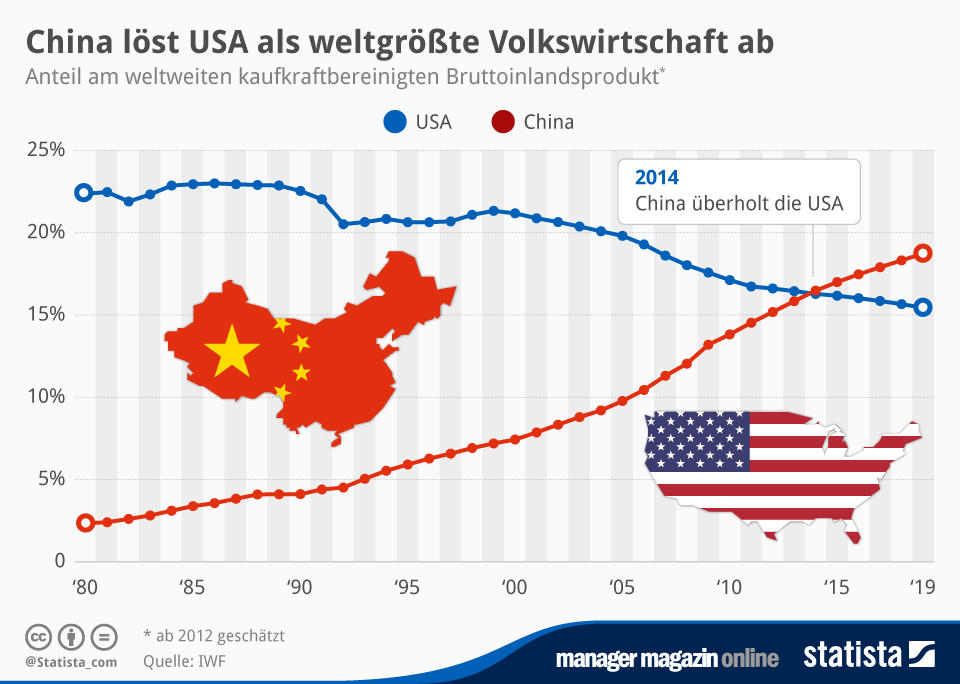
According to the latest IMF forecast from 2020, the US will remain the leading economy in 2025. Seen here, in the top 10 countries, with the largest gross domestic product (GDP) from 2019 to 2025 (in billions of US dollars). First a look at the current year, then the forecast for 2023 to 2025.
Source: Statista.
Growth in comparison: Current
| 2020* | 2021* | 2022* | |
| USA | 20.807,27 | 21.921,59 | 22.967,65 |
| China | 14.860,78 | 16.492,81 | 17.933,63 |
| Japan | 4.910,58 | 5.103,18 | 5.337,33 |
| Germany | 3.780,55 | 4.318,49 | 4.556,81 |
| India | 2.592,58 | 2.833,87 | 3.094,18 |
| United Kingdom | 2.638,3 | 2.855,67 | 3.004,8 |
| France | 2.551,45 | 2.917,67 | 3.060,62 |
| Italy | 1.848,22 | 2.111,65 | 2.207,85 |
| Brazil | 1.363,77 | 1.431,62 | 1.562,62 |
| Canada | 1.600,26 | 1.763,05 | 1.876,7 |
Growth forecast (IMF): 2025
| 2023* | 2024* | 2025* | |
| USA | 23.913,12 | 24.833,76 | 25.783,44 |
| China | 19.512,74 | 21.217,57 | 23.029,81 |
| Japan | 5.626,63 | 5.848,65 | 6.014,28 |
| Germany | 4.726,37 | 4.877,58 | 5.040,94 |
| India | 3.368,9 | 3.657,45 | 3.958,81 |
| United Kingdom | 3.120,06 | 3.239,2 | 3.356,79 |
| France | 3.183,64 | 3.299,49 | 3.411,71 |
| Italy | 2.280,1 | 2.333,36 | 2.387,83 |
| Brazil | 1.665,97 | 1.786,91 | 1.891,43 |
| Canada | 1.983,49 | 2.086,82 | 2.193,41 |
Population and GDP development: forecasts 2025
Not only is China one of the big players, the country continues to grow, as seen here, in total population from 1980 to 2018 and projections to 2025, with the population approaching one and a half billion by 2025.
- 2025 – 1,417 billion +0.9 %
- 2020 – 1,404 billion +2.18 %
- 2015 – 1,374 billion + 2.53 %
- 2010 – 1,340 billion + 5.76 %
- 2000 – 1,267 billion + 10.84%
- 1990 – 1,143 billion
- 1980 – 987.05 m
- …
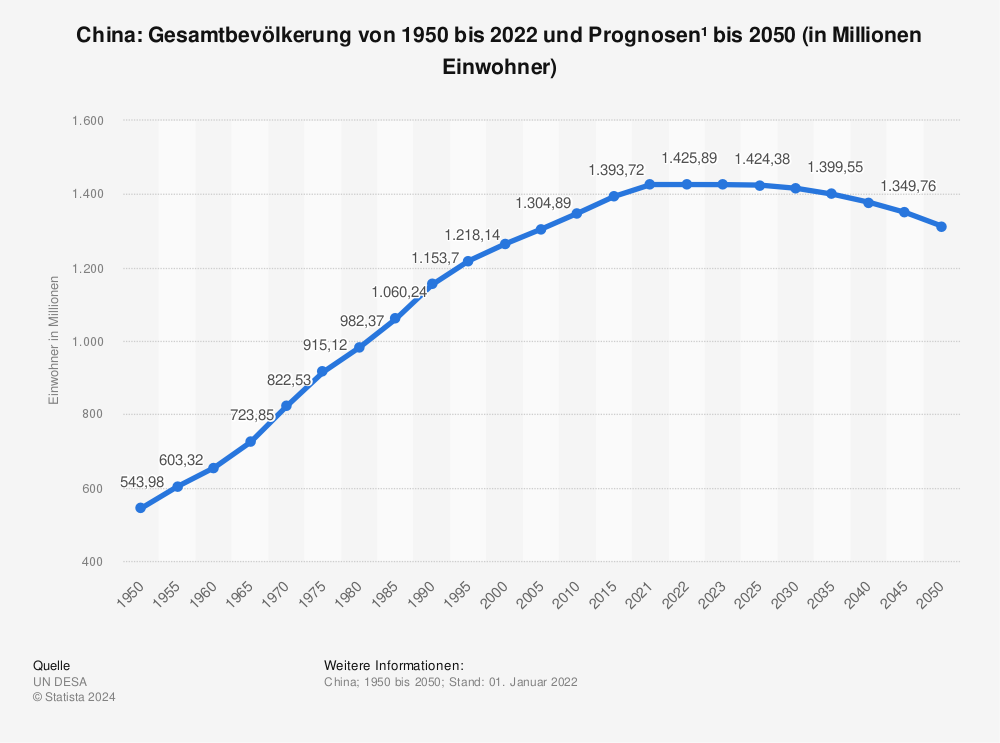
More and more inhabitants are earning more and more money. Since 2006/2008, the gross domestic product has been rising almost inexorably. Since statistics are worth a thousand words, here is the gross domestic product (GDP) in current prices, from 1980 to 2019 and forecasts, again with forecast to 2025 (in billions of US dollars).
- 2025 – $23,029 billion + 54.97 %
- 2020 – $14,860 billion + 33.71%.
- 2015 – $11,113 billion + 84.20%
- 2010 – $ 6,033 billion + 163.44 %
- 2005 – $ 2,290 billion + 90.04 %
- 2000 – $1,205 billion
- 1990 – $396 billion
- 1980 – $303 billion
- …

Here you can see once again the real growth of the gross domestic product (GDP) from 1980 to 2019 and forecasts to 2025 (compared to the previous year) visualized.
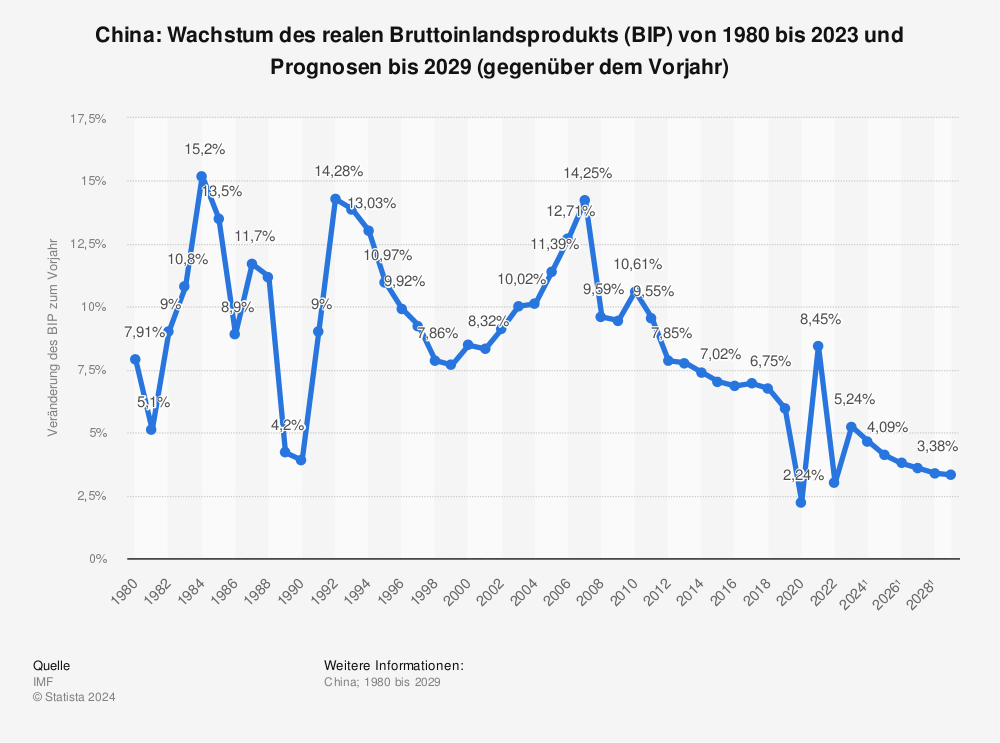
What does that mean per person? If you divide the GDP among individuals, it shows that the purchasing power of individuals in China is increasing and increasing. Another indicator that makes China one of the current and future sales markets.
- 2025 – 16.284,03 $ + 50,22 %
- 2020 – 10.839,44 $ + 34,07 %
- 2015 – 8.084,80 $ + 79,67 %
- 2010 – 4.499,79 $ + 373,08 %
- 2000 – 951,15 $ + 174,21 %
- 1990 – 346,86 $
- 1980 – 307,00 $
- …
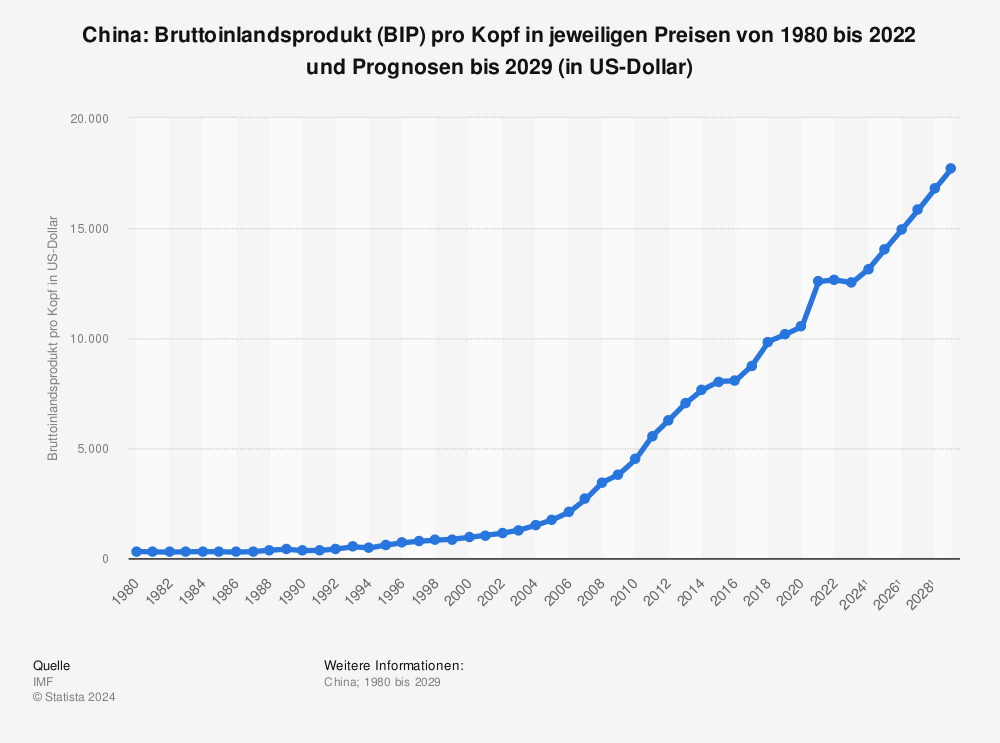
Target group China: age and structure
Who buys? The target group and product offering must harmonize in order to make sales. A key look when identifying target audiences in marketing, including in the Chinese market, is current age and upcoming age. Why?
Customer Lifetime Value – Simply put, “repeat customers.” Does a customer make a one-time purchase of a product or service, or does our one-time customer, become a returning customer? As with e-commerce optimization, it’s all about building loyalty to our product.
People in China are getting older, accordingly a product can, in the long run, grow with the target group. A typical example here: Automobile industry. Some car models achieve such a “cult status” among the respective brand followers that subsequent models are bought almost automatically.
Here’s a quick look, at the average age of the population, from 1950 to 2020 and projections to 2050. By 2050, 30 years from now, the population in China will be + 9.4 years older on average, from 38.4 years currently to 47.6 years.
- 2050 – 47.6 years (+ 1.3 years)
- 2040 – 46.3 years (+ 3.7 years)
- 2030 – 42.6 years (+ 4.2 years)
- 2020 – 38.4 years (+ 3.2 years)
- 2010 – 35.2 years (+ 5.1 years)
- 2000 – 30.1 years
- …
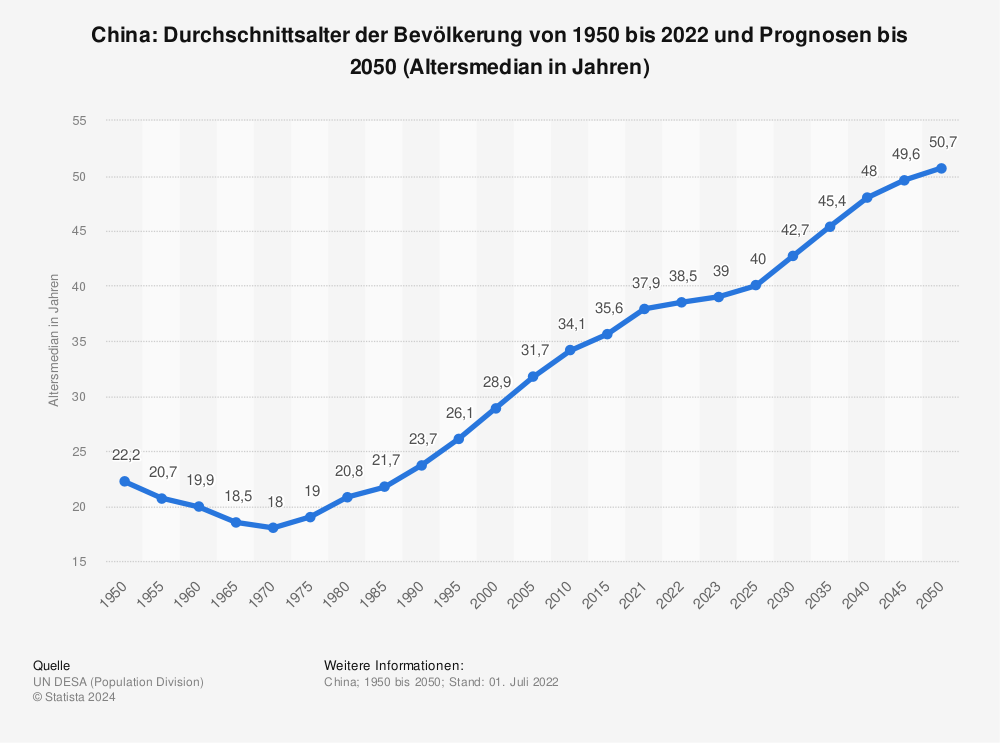
As learned above, the country currently has a total purchasing power of $16,000 billion at its disposal. But, how much of that goes to imports? Currently, about 12.5%, or 2,000 / 16,000 billion. To see here, on the import of goods from 2009 to 2019 (in billions of US dollars).
- 2019 – $2,077.1 billion + 23.67%.
- 2015 – $1,679.57 billion + 20.29%.
- 2010 – $1,396.25 billion
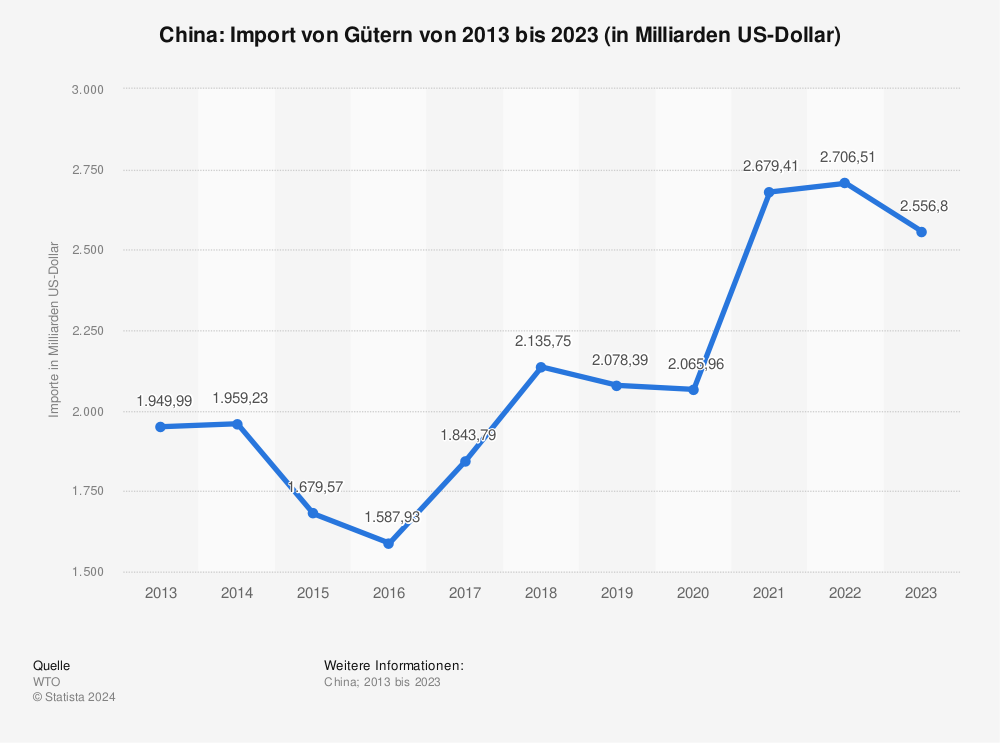
What share do goods and services from Germany have in Chinese imports? Here you can see the value of German exports to China from 2007 to 2019 (in billions of euros).
- 2019 – $95.98 billion (+$24.7 billion)
- 2015 – $71.28 billion (+$17.49 billion)
- 2010 – $53.79 billion (+23.89 billion)
- 2007 – $29.9 billion
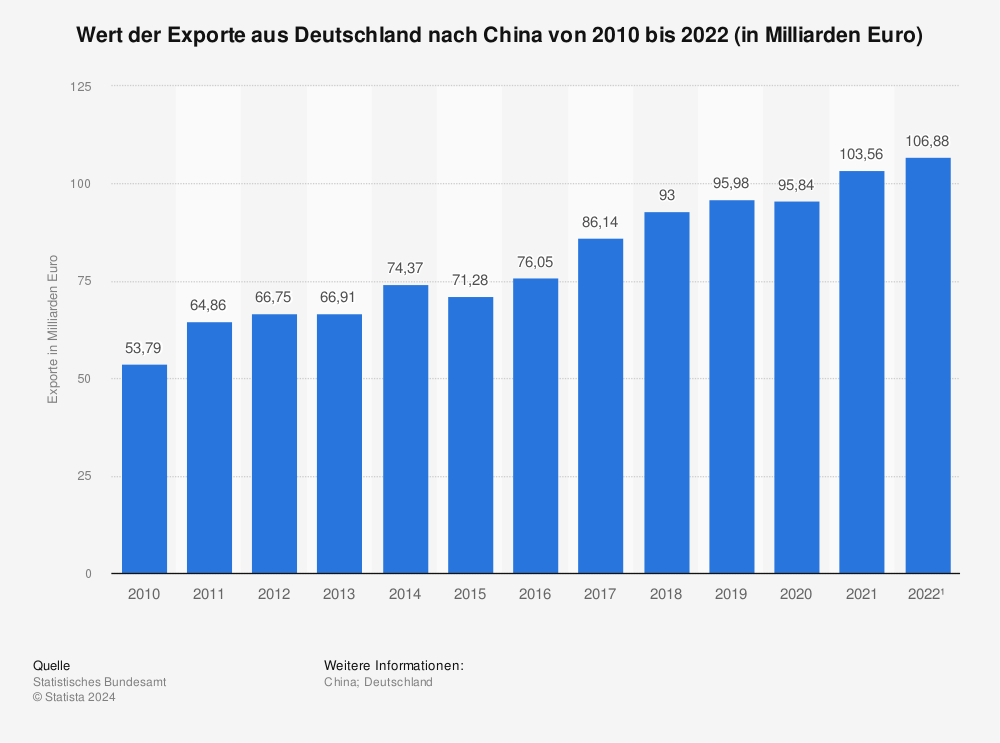
Media Mix in China: Strategies
As already mentioned at the beginning, Chinese use completely different platforms than Europeans or Americans when it comes to obtaining information.
Communication with friends, celebrity news, shopping to paying at restaurants and for online stores, does not take place on separate platforms here, but often in a single app.
Apps like WeChat are also much more comprehensive. They are social network, users do their online banking through the app, much more even, even simple payment at the supermarket or, as mentioned above, at the restaurant, are possible with the app.
Accordingly, you need for your brand on the one hand, a marketing concept and on the other: A completely new customer journey, when “everything” takes place in an app. Customer journey means the path of the user, from acquisition to lead (desired conclusion, from newsletter to product sale). In comparison: someone searches for a product on Google, clicks there, comes to e-commerce, puts a product in the shopping cart, registers as a customer and pays.
- Marketing concept
- Customer Journey
Besides WeChat, there are other apps that a large portion of the population actively uses. Here is a brief review of the top 10 social networks in China:
- WeChat – 78%
- Sina Weibo – 56%
- Baidu Tieba – 50%
- Xiaohongshu – 39 %
- Tencent Weibo – 36%
- Kuaishou – 32%
- Douban – 23%
- Douyu – 20%
- LinkedIn – 20%
- Meitu – 15%
- …
Solutions for German companies in China
Solutions for German companies in China are always individual – for market entry, whether physical or only medial, there is no simple 1-2-3 roadmap that shows the way. For more complex products, the solutions are even more individual, for example for companies in mechanical and plant engineering. Here, it is no longer sufficient to “only” place advertisements.
Therefore, the very first step is to have a conversation. What are your / yours:
- Assortment, products and A-products
- Target group
- Company and structure
- Employees and capacities
- Competition and local competition
- Key market figures on site
From this, the first strategies are formulated, from pure e-commerce marketing, to local partners on the ground, with sales structures.
But before we get too far into the subject, let’s get back to basics.
Market barriers and communication management
China, as I’m sure you know, is a very regulated country and actions have to be considered in advance. Unlike in the European Union or in Germany, you need local partners for a lot of marketing and advertising.
Our agency also had to communicate with many partners in the first weeks, the focused work in China, in order to create trust. Only then did we get the appropriate approvals, for example for advertisements in individual apps, or the opportunity to work with local partners on site and their system and / or structures.
The market entry itself is much more difficult than, for example, an advertising campaign in France, a direct neighbor and member of the European Union. Especially when it comes to reach millions of people with a message as a company with an advertising budget, not twice but three times as much attention is paid to the action(s).
In particular, the platforms that are based in China want to protect themselves from possible violations. Accordingly, the selection of advertising partners is very selective. The longer one is active as a marketing agency in China, the more freedom and desires are approved.
Social Media One: Bridge to USA & China

Marketing agency: 3-point strategy
Our marketing agency has been specializing in global marketing since 2018. With a focus on digital media and performance marketing. Our services include social media marketing, as well as native advertising and search engine advertising. This gives our clients a presence in all new, important media.
How do we work?
Marketing concept and strategy
Our strategy employs a 3-point strategy: Firstly advertising (new people), secondly advertising on keywords (interested / searching people) and for interested people referral marketing (checking people).
- Advertising (new people)
- Advertising on keywords (interested / searching persons)
- Referral marketing (reviewing persons)
The goal is to reach all potential buyers. How do we achieve this goal for our customers? We rely in particular on digital marketing, state-of-the-art in the 20s.
- Social Media – Content Marketing & Advertising<
- Search engines – Advertising on keywords
- Blogs, magazines and online portals – recommendation marketing
These are the core elements of our marketing strategies, also in China. With this, potentially interested parties, at all important points, are addressed and also addressed again(social ads / remarketing).
1) Through advertising, you reach people for your company and your products, who have not yet had contact with it. Through 2) advertisements in search engines, the people are addressed who are actively looking for specific information at this very moment. In a 3) further step, we rely on recommendation marketing, for example through tests by bloggers, comparisons, testimonials on magazines and online portals.
Online first: Complementary offline methods
In addition, there are other methods and strategies, depending on which strategy has been worked out for the respective company or the individual product and campaign. These could be, for example, posters, printed and in the streets of the city of Shanghai and Beijing or also influencer marketing actions, i.e. reputation marketing, by brand advocates. In China, trends are picked up quickly, so virtual influencers are also part of the mix. In particular, these local multipliers ensure that a campaign is not only seen, but really, as relevant information, perceived by the prospect on the ground.
Start a company in China: Company (List)
Founding a company in China? This question comes up relatively often for companies that want to expand to China. In Europe, as well as in America, people are used to the fact that setting up a company for activities in the local market is relatively easy. In China, however, it is the case that every time a foreigner sets up a company, a Chinese partner must be involved.
You can find more information about the company models here (external).
- Representative Office
- Company with exclusively foreign participation (WFOE)
- Foreign trading companies (FICE)
- Joint venture – joint ventures
- Partnerships with foreign shareholders (Foreign Invested Partnerships)
- Branches

Contact and contact person
Do you have questions, ideas or are you already planning a concrete project and looking for support and solutions? Get in touch with our contact persons for China.

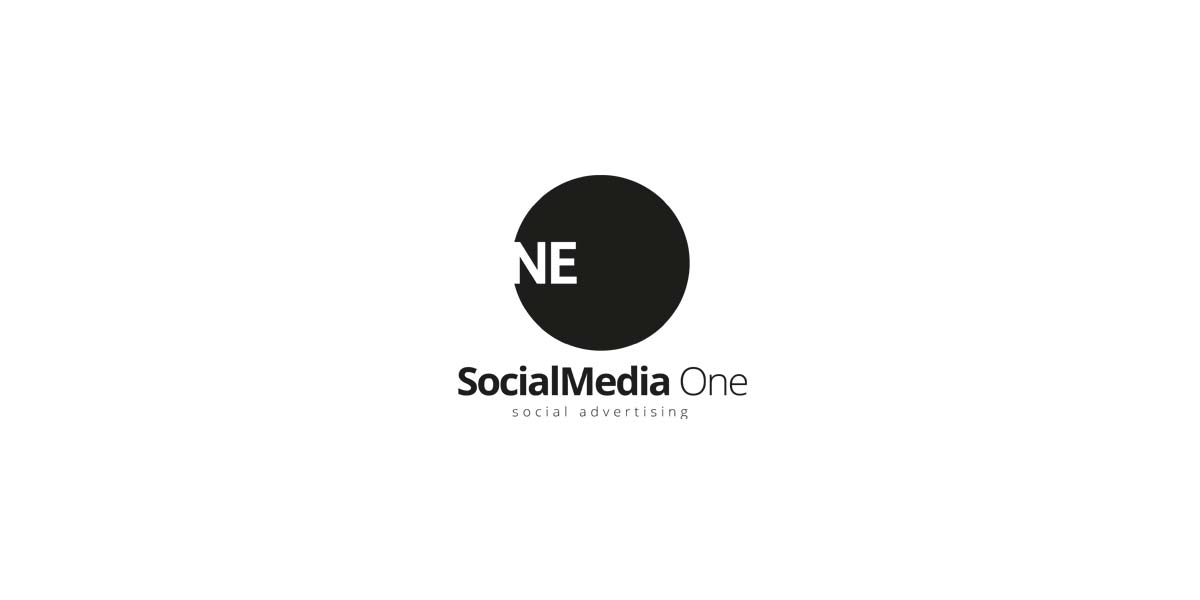











 4.9 / 5.0
4.9 / 5.0